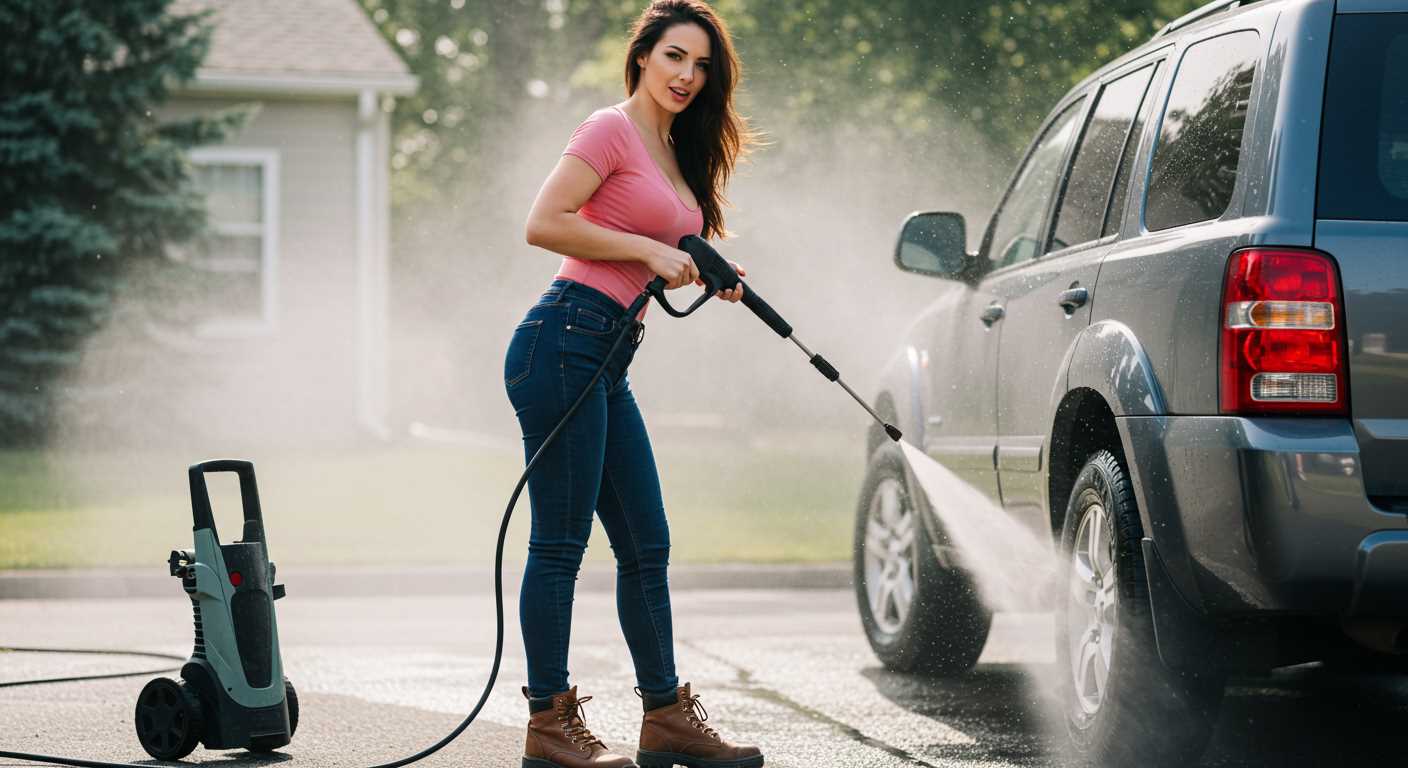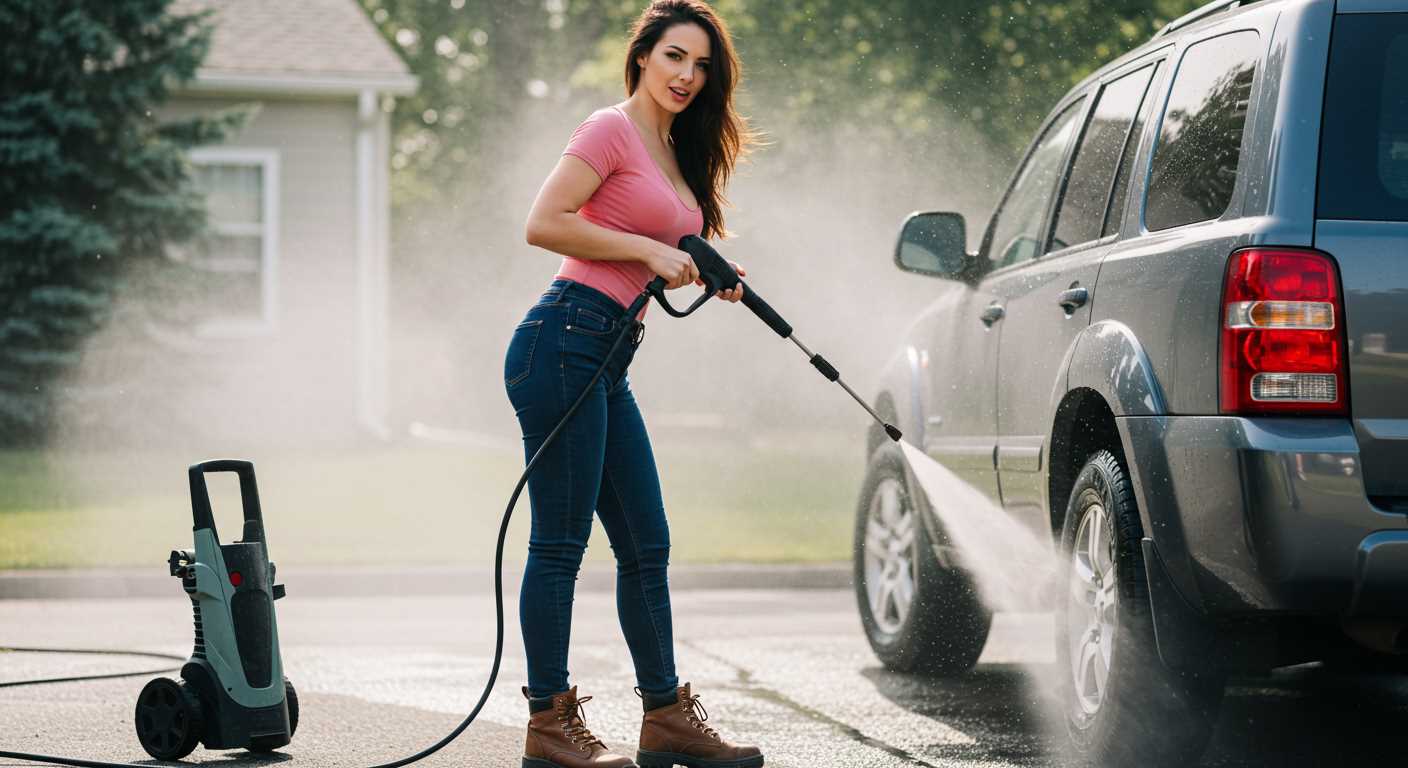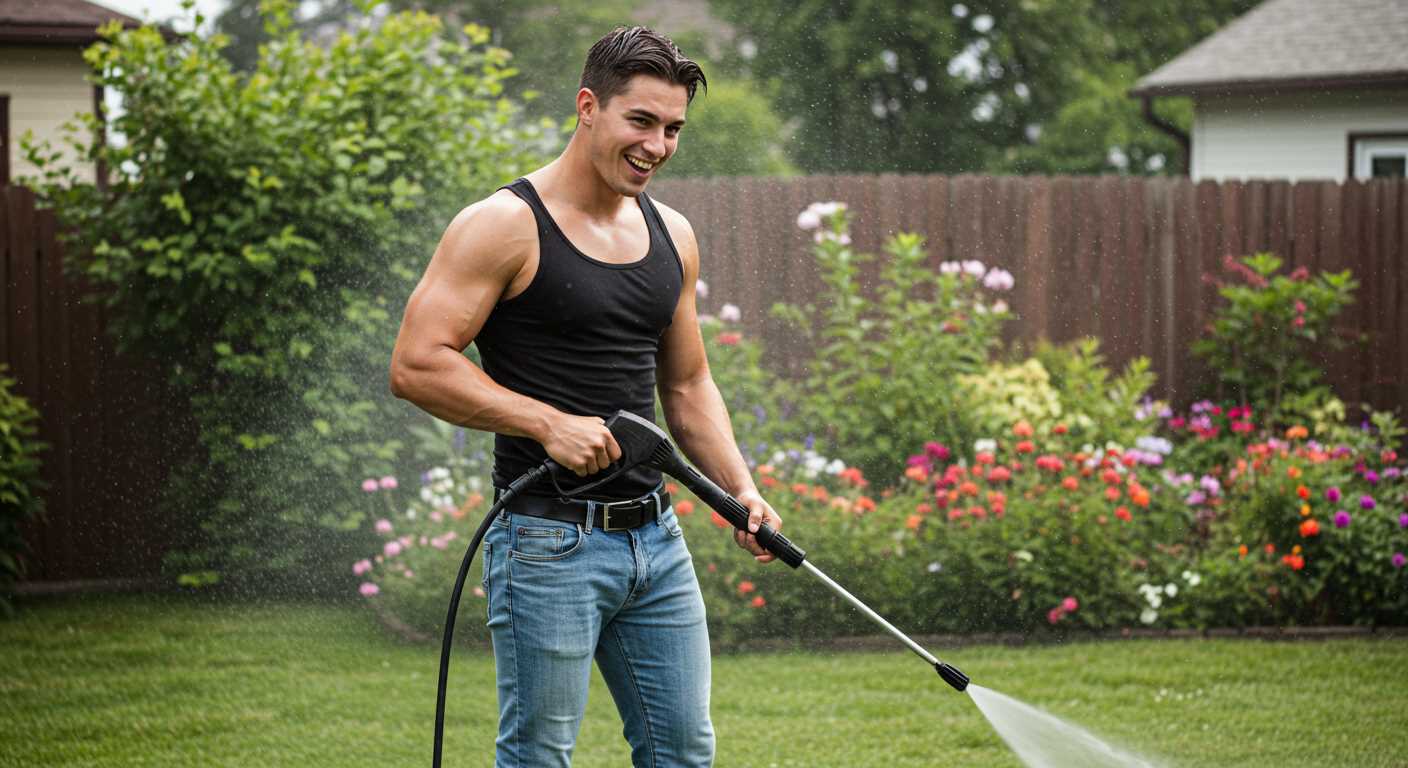


For optimal results, always dilute the cleaning agent according to the manufacturer’s guidelines before introducing it into your machine. A common ratio is one part solution to four parts water, but this can vary based on the specific product in use. Ensuring the right concentration not only enhances cleaning efficiency but also protects your equipment from potential damage.
Attach the solution container securely to the applicator. It’s crucial to check for a tight fit; any leaks can lead to a messy situation and wasted product. Once connected, adjust the setting on your device to the appropriate mode for applying the cleaning mixture. Most models have a dedicated setting for this purpose, which allows for an even distribution of the cleaning agent.
As you begin the cleaning process, start from the top and work your way down. This technique ensures that dirt and grime are effectively rinsed away without resettling on previously cleaned surfaces. Always maintain a consistent distance between the nozzle and the surface being treated–typically around 30 centimetres–to achieve the best results.
After applying the mixture, allow it to dwell for a few minutes for maximum penetration before rinsing. This step is often overlooked but is essential for breaking down tough stains. Finally, switch back to fresh water for rinsing, ensuring to clear any residual cleaning solution from the system. This will help maintain the longevity of your machine and ensure each cleaning session is as effective as the last.
Utilising the Cleaning Solution Container with the K4 Unit
To begin, ensure the cleaning solution is compatible with your equipment. The K4 model is designed to accept specific formulations, so double-check the label. Once you’ve confirmed compatibility, fill the container to the indicated level. Avoid overfilling, as this can lead to spillage during operation.
Next, attach the container securely to the designated slot on the unit. A firm connection is necessary to prevent leaks. Once attached, adjust the nozzle on your lance to the low-pressure setting. This is crucial for proper solution application. A high-pressure setting will not allow the cleaning agent to dispense effectively.
Activate the machine and start applying the solution to the surface you intend to clean. Move in a sweeping motion, ensuring even coverage. Allow the cleaning agent to dwell for several minutes to break down dirt and grime. This waiting period is essential for optimal results.
After the dwell time, switch to the high-pressure setting. Rinse the area thoroughly to remove any residue. This step is vital to ensure the surface is clean and free from any cleaning agent remnants. For those looking to clean specific areas, such as driveways or patios, consider exploring a pressure washer for pavement for enhanced performance.
Finally, after use, detach the container and rinse it out. This prevents any leftover solution from clogging the system or affecting future cleaning tasks. Regular maintenance of the container and the machine will extend their lifespan and improve performance.
Choosing the Right Detergent for Your Karcher K4
Select a formulation designed specifically for high-pressure cleaning. Many brands offer options that enhance cleaning efficiency without damaging surfaces. Look for biodegradable choices to minimise environmental impact while ensuring effective grime removal.
Consider the specific task at hand. For example, if you’re tackling vehicle cleaning, a car shampoo will provide the necessary lubricants to lift dirt without scratching the paint. For patios or driveways, opt for a heavy-duty cleaner that can penetrate tough stains like oil or algae.
Check the pH level of the cleaner. A neutral pH (around 7) is safe for most surfaces, while acidic or alkaline solutions can be harsh on certain materials. Always refer to the manufacturer’s recommendations to avoid any potential damage.
Concentrated formulas are often more economical, allowing you to dilute them according to the level of cleaning required. This flexibility can save you money in the long run while still providing outstanding results.
When selecting a cleaner, ensure it’s compatible with the Karcher system. Using non-compatible products can lead to malfunctions or void warranties. It’s worth investing time in reading labels and product descriptions.
Lastly, consider user reviews and recommendations. Real-world experiences can provide insight into the effectiveness and ease of use of a particular cleaner, helping you make an informed decision based on others’ successes.
Preparing the Detergent Container for Operation
First, ensure the container is clean and dry. Residual substances can interfere with the performance of the cleaning agent. Rinse it thoroughly with water before adding anything new.
Filling the Container
Pour the chosen cleaning agent into the container, following the manufacturer’s recommended dilution ratio. For some products, a concentrated formula may need to be mixed with water in specific proportions. Always refer to the label for guidance.
Checking Connections
Before attaching the container to the machine, inspect the connections for any signs of wear or damage. A secure fit is necessary to prevent leaks during operation. Make sure the threading matches and that the seals are intact.
| Action | Description |
|---|---|
| Rinse Container | Remove any remnants from previous use. |
| Add Cleaning Agent | Follow dilution instructions for optimal results. |
| Inspect Connections | Ensure all parts fit securely to avoid leaks. |
Once everything is prepared, attach the container securely to the machine. This step is crucial for maintaining proper functionality during your cleaning tasks.
Attaching the Detergent Reservoir to the High-Pressure Cleaner
First, ensure that the device is powered off and unplugged for safety. Locate the designated area on the machine where the reservoir fits. Often, this is situated near the front or side of the unit.
Align the attachment points of the reservoir with the corresponding slots on the cleaner. A gentle push should secure it in place. Listen for a click or feel for a snug fit, indicating that it’s properly connected.
After securing the reservoir, double-check that it’s firmly attached. A loose connection can lead to leaks or affect the performance of the cleaning solution. If any resistance is felt during the attachment process, reassess the alignment and ensure there are no obstructions.
Once in place, the next step is to connect the nozzle that allows for the application of the solution. This typically involves swapping the current nozzle for one designed to dispense the cleaner. Follow the manufacturer’s instructions for this transition, ensuring compatibility.
With everything connected, you’re ready to fill the reservoir with your chosen cleaning solution. Make sure to avoid overfilling, as this can cause spillage during operation. Close the cap securely before starting the machine.
Adjusting the Detergent Flow Settings
To fine-tune the flow of cleaning solution, first locate the adjustment dial on the front of the unit. This dial typically ranges from low to high settings, allowing for flexibility based on the task at hand. For light cleaning tasks, like washing a car, set it to a lower flow. Conversely, for heavier grime on driveways or patios, crank it up to maximise the output.
During my years testing various models, I found that starting at a mid-level setting often yields the best results. It prevents waste while providing enough cleaning power. After applying the solution, I recommend letting it sit for a few minutes to break down dirt, then rinsing with clear water at a higher pressure to ensure all residues are removed.
If you notice that the mixture isn’t foaming adequately, try adjusting the flow slightly. A too-high setting may dilute the cleaner, while a too-low setting may not effectively spread it. Each surface may require a different approach, so don’t hesitate to experiment and find what works best for your specific needs.
Keep an eye on the container as well. If you’re running low, it’s a good idea to check the flow settings to ensure you’re not wasting what little remains. I’ve had instances where I underestimated my supply, only to be left with a half-finished task. Adjusting the settings accordingly can help stretch the cleaner just a bit longer.
Applying detergent to surfaces effectively
For optimal cleaning, begin by selecting the right surface. Soft materials like car paint or delicate outdoor furniture require a gentle approach, while tougher surfaces like concrete or brick can handle a more aggressive application. Always test a small, inconspicuous area first to avoid damage.
Technique Tips
- Maintain a distance of approximately 30 cm from the surface. This helps to prevent concentrated streams from causing any harm.
- Apply in a sweeping motion, moving from top to bottom. This ensures that dirt and grime flow downward and are lifted away efficiently.
- Allow the solution to dwell for a few minutes. This wait time helps to break down stubborn stains, making them easier to remove.
Additional Recommendations
- Rinse the surface thoroughly after application. This ensures no residue is left behind that could attract dirt.
- Consider environmental factors like temperature and humidity. Warmer, drier conditions can speed up drying times, while cooler, wetter weather may require adjustments in application.
- For heavily soiled areas, a second pass may be necessary. Reapply the solution as needed, following the same technique.
Also, don’t forget to stay informed about the latest advancements in cleaning technology. You might find interesting insights on topics like are digital cameras better than cell phones, which can enhance your understanding of product functionalities.
Switching to high-pressure mode after detergent application
After applying the cleaning solution, it’s time to transition to high-pressure mode for rinsing. Follow these precise steps to ensure optimal results:
- Ensure that the application nozzle is replaced with the high-pressure one. This is typically a different attachment designed for powerful water flow.
- Adjust the flow settings back to the high-pressure option on the machine. This often involves turning a dial or switching a lever, depending on your model.
- Start your equipment again. Let it run for a few seconds to build up the necessary pressure before beginning the rinsing process.
- Begin rinsing from the top of the surface downwards. This method ensures that any remaining residue is washed away effectively.
- Maintain a consistent distance from the surface, usually around 30cm, to avoid damage while ensuring thorough cleaning.
In my experience, many overlook the importance of rinsing immediately after applying the solution. I recall a time when I waited too long, and the cleaner dried, leaving streaks that took much longer to remove. Timing is key–rinse while the solution is still active to achieve the best finish.
Always remember to keep an eye on the pressure settings, as some surfaces may require adjustments to avoid damage. Regularly check the effectiveness of your rinsing technique and adjust your distance and angle as needed.
Finally, once rinsing is completed, allow the surface to dry naturally for optimal results. This will help prevent any residual streaking or soap scum from forming.
Cleaning and Maintaining the Detergent Bottle
After applying cleaning agents, it’s crucial to ensure the container is properly cleaned. I remember one occasion where I neglected this step, and the residue caused blockages during my next use. To prevent this, rinse the container immediately after finishing your task. Use warm water and shake it thoroughly to remove any remaining solution. This prevents buildup and keeps the system functioning smoothly.
Regular Inspection
Check for any cracks or leaks in the container. I once had a small crack that I overlooked, leading to a messy situation during my next cleaning session. If you spot any damage, replace the container to avoid further complications. Additionally, inspect the cap for tightness and the sealing ring for wear and tear, ensuring a secure fit for optimal performance.
Storage Tips
Store the container in a cool, dry place away from direct sunlight. I learned the hard way that extreme temperatures can warp the material, making it less effective. Keeping it clean and well-stored prolongs its lifespan and ensures that it’s ready for your next cleaning project.
Storing the Cleaning Solution Safely and Properly
Keep your cleaning products in a cool, dry place away from direct sunlight. This helps to maintain their effectiveness and prevents degradation. I’ve found that a dedicated storage box or cabinet works wonders for organisation and safety. Ensure it’s out of reach of children and pets, as some solutions can be harmful if ingested.
Always check the original container for any specific storage instructions. Some formulations require certain temperatures or humidity levels to remain stable. I once neglected this and had a bottle burst due to heat, creating quite the mess and wasting a lot of product.
Label everything clearly, especially if you have multiple types or brands. I’ve seen confusion arise when similar-looking containers are involved. It’s easy to mix them up, which can lead to improper application and results. Using waterproof labels can also help in case of spills.
Maintain an inventory of your supplies. It’s surprising how quickly items can get used up, and knowing what you have on hand prevents last-minute trips to the store. I keep a simple checklist in my storage area to track what’s available.
If possible, use original containers for storage. These are designed to hold the contents safely and securely. Transferring to different bottles can lead to leaks or reactions with the new material. I learned this the hard way when a plastic bottle I used began to degrade, spilling its contents.
Regularly inspect your supplies for any signs of damage or expiry. I make it a habit to check every few months. If a container is bulging, leaking, or has an unusual smell, dispose of it safely. Following local regulations for hazardous waste disposal is important to minimise environmental impact.
For long-term storage, consider using a climate-controlled space if you live in an area with extreme temperature fluctuations. I’ve found that this simple measure can significantly extend the life of my products, saving both money and time in the long run.





.jpg)


